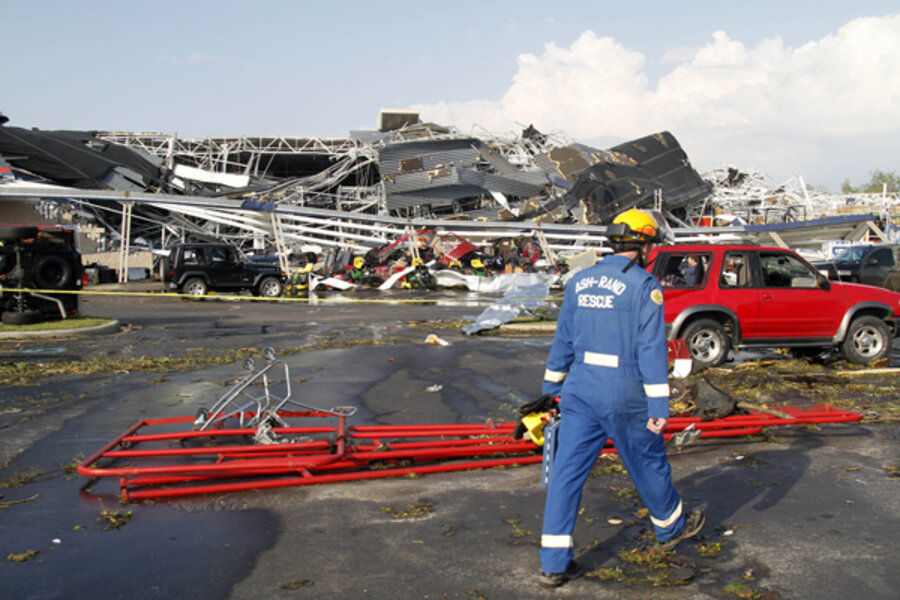Why North Carolina, far from Tornado Alley, took brunt of big outbreak
Loading...
| Atlanta
In Sanford, N.C., a heads-up store manager is credited with saving 70 frightened shoppers as a tornado ripped off the roof of a Lowe's hardware outlet. In Raleigh, N.C., a tornado found its favorite victim, tearing apart most of a trailer park.
In Bertie County, N.C., 11 people died as twisters – progenies of an epic clash of atmospheric fronts – split trees, toppled cars, and blew apart homes, as Gov. Bev Perdue said, as if they were paper doll houses.
A rival to the "Super Tuesday" tornado outbreak in February 2008 that killed 56 people across four Southern states, this weekend's storm spawned 243 tornadoes from Oklahoma to Virginia. At least 45 people died during the tornado outbreak. North Carolina saw the greatest human toll, with 22 confirmed dead, and search and rescue teams still combing a huge impact area for more victims.
Can you outsmart a tornado? Take our quiz.
Hundreds more were injuried, many seriously, as a "family" of twisters spun out of a severe disturbance caused by a fast-moving, low-level front being undercut by colder winds coursing through the upper atmosphere.
The severity and type of storm – it's rare for North Carolina to see large, visible Tornado Alley-type twisters – is linked to a strong Pacific-born La Niña system confronting the same north Atlantic "oscillation" that has produced two unusually cold and snow-filled Southern winters in a row. The last such super storm in North Carolina came in the spring of 1984, which spawned 20 twisters and killed 43.
"This was an amazing event," says Anthony Lupo, a tornado expert at the University of Missouri, in Columbia. "You had 120 tornado reports from Maryland down to South Carolina in one day, and they were pretty well focused on North Carolina. This is probably going to top 1984 as their worst event.
"The difference between this storm system and what you typically see in that part of the world is that typically these storms will be hidden by rain," adds Mr. Lupo. "These storms were visible, where the rain curtain gets detached from the tornado."
Tales of heroism and close escapes emerged Monday as residents took stock of the damage and victims began putting their lives back together. At the Lowe's in Sanford, a store manager who shuttled 70 shoppers into a windowless area in the back of the store is being credited with quick thinking that probably saved lives. Even so, the tornado rolled one man through an aisle like a bowling ball. No one was seriously hurt, however.
"Luckily we got everybody to the back before it hit us, but as it was hitting us, we were kind of running and the roof was kind of peeling off," the manager, Michael Hollowell, told ABC News Radio.
In Dunn, N.C., a tornado ripped a baby out of his cousin's arms as a trailer home came apart. The baby was found alive on top of a nearby wood pile. “I seen him leave my arms. That’s how strong the wind was," Jonathan Robinson told reporters.
The storm destroyed more than 60 homes in North Carolina and at least 100 others were heavily damaged. One damaged home belonged to Audrey McKoy of Bladen County, N.C., who described a "Wizard of Oz"-like scene as she watched a tornado turn and head straight for her home.
Ms. McKoy told the Associated Press that it took her and her husband a few minutes after the twister blew over to realize that their home had been completely turned around, and was now sitting in their backyard.
Mr. Lupo, the University of Missouri tornado expert, said the deep dips of cold air into the South that have chilled the region over the past two winters likely played a role in Saturday's vicious super cell storm, as well.
"There's definitely a connection there, that if you have more cold air intrusions further into the South, the more likely it is that you're going to get one of these things to just really fire up a lot of storms."





